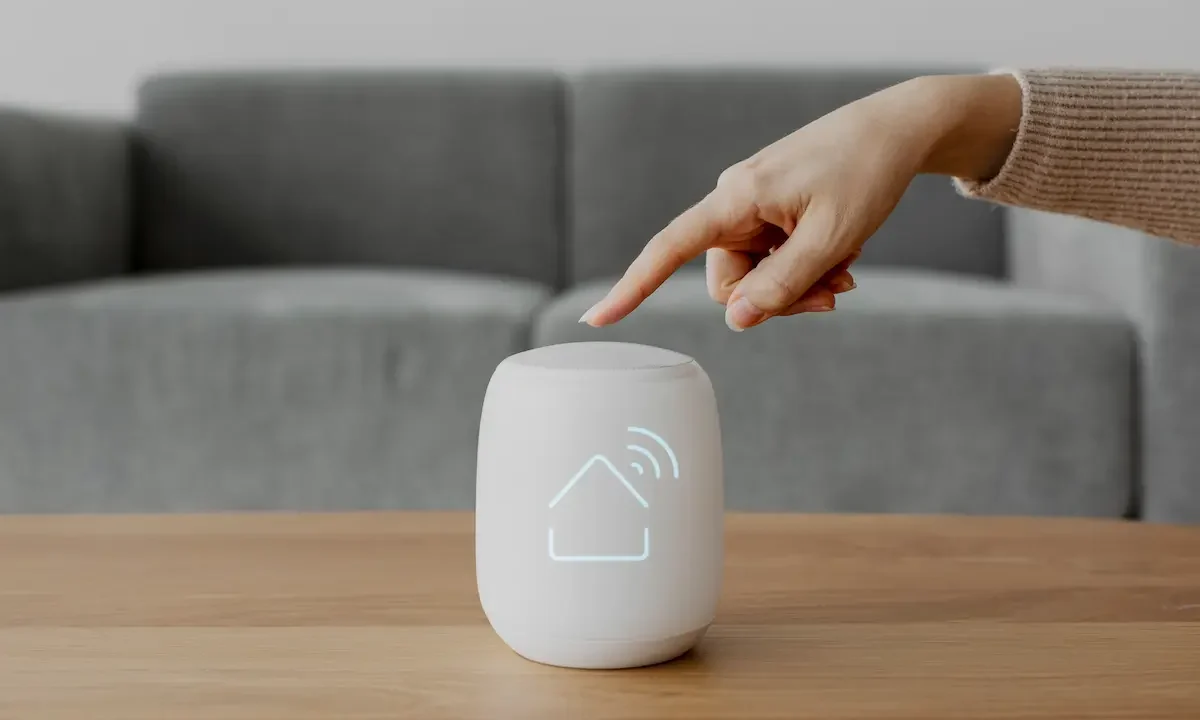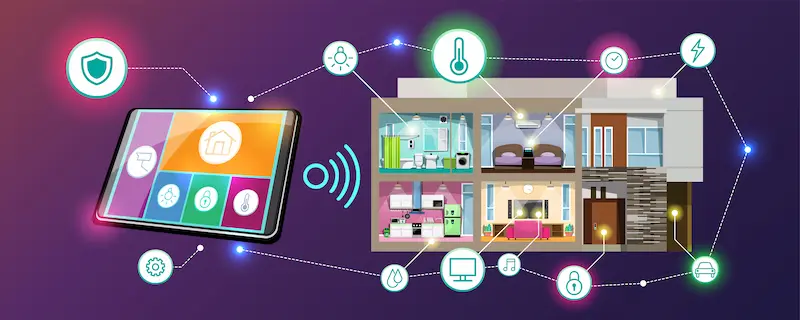- Home
- AI & Tech Tools
- Smart Home Devices for Beginne ...

Are you thinking about turning your house into a smart home but not sure where to start? You’re not alone. Smart home devices for beginners are becoming more accessible, affordable, and easy to set up than ever before. From voice-controlled lights and smart plugs to security cameras and thermostats, these gadgets are designed to make everyday life more convenient, energy-efficient, and secure.
In this beginner’s guide, we’ll walk you through the essential smart home devices that are perfect for first-time users. Whether you’re looking to dip your toes into home automation or build a fully connected living space, this article will help you understand what devices to choose, how they work, and how to get started without feeling overwhelmed.
Let’s explore how smart home technology can transform your home step by step.

What is a Smart Home?
A smart home is a residence equipped with internet-connected devices that allow homeowners to monitor, manage, and automate various household functions—such as lighting, heating, cooling, entertainment, and security—remotely and intelligently.
Smart home devices communicate with each other using wireless technologies like Wi-Fi, Zigbee, or Z-Wave, and they can often be controlled through a smartphone app, voice assistant (like Amazon Alexa or Google Assistant), or a centralized smart hub.

Key Features of a Smart Home:
- Automation: Smart homes enable automatic control of lights, thermostats, and other appliances based on your preferences, time schedules, or sensor data.
- Remote Access: You can control and monitor your devices anytime, anywhere—from your phone or tablet.
- Voice Control: Most systems integrate with virtual assistants, so you can simply say, “Turn off the lights,” or “Set the temperature to 72°F.”
- Energy Efficiency: Devices like smart thermostats and lighting systems help reduce energy consumption, lowering utility bills.
- Security & Safety: Smart locks, cameras, and alarms offer real-time alerts and control, enhancing home safety even when you’re away.
- Integration & Customization: Multiple devices can work together—for example, your smart lights can turn on when your smart door unlocks, or your thermostat can adjust automatically when you leave home.
The Technology Behind Smart Homes:
- Internet of Things (IoT): This is the backbone of smart homes, connecting devices and enabling real-time communication.
- Artificial Intelligence (AI): Many smart systems learn your habits and adjust accordingly for better comfort and efficiency.
- Connectivity Protocols: Devices communicate using wireless technologies like Wi-Fi, Bluetooth, Zigbee, or Z-Wave.
In Simple Terms:
A smart home is not just about cool gadgets—it’s about creating a connected, efficient, and secure living space that adapts to your lifestyle, saves energy, and adds convenience to your daily routine.
Benefits of Smart Home Devices
Smart home devices offer a wide range of benefits that make everyday living more comfortable, efficient, and secure. From saving energy to enhancing convenience, these connected technologies are rapidly changing the way we interact with our homes.
1. Unmatched Convenience
Smart homes simplify daily routines. With just a tap on your smartphone or a voice command to Alexa or Google Assistant, you can control lights, adjust the thermostat, or lock your doors. Automation allows routine tasks—like turning off lights or brewing coffee—to happen without you lifting a finger.
2. Energy Efficiency & Cost Savings
Smart thermostats, lighting systems, and appliances are designed to optimize energy use. For instance, lights can turn off automatically when no one is in the room, and thermostats can adjust based on your schedule—helping you save on utility bills while reducing your carbon footprint.
3. Enhanced Home Security
Smart cameras, video doorbells, motion detectors, and smart locks offer real-time monitoring and alerts. You can view live footage from your phone, get instant notifications of suspicious activity, or remotely lock your doors—all adding an extra layer of protection to your home.
4. Accessibility & Assistance
For individuals with disabilities or mobility issues, smart home devices provide independence. Voice control, smart door openers, and automated lighting make homes more accessible and user-friendly.
5. Remote Monitoring & Control
Whether you’re at work or on vacation, you can check in on your home at any time. Forgot to turn off the AC? No problem—just open the app and turn it off remotely.
6. Integration & Personalization
Smart homes can learn your habits and adjust accordingly. For example, your lights can dim when it’s bedtime, or your thermostat can warm the house just before you arrive home from work.
Consider the Risks (And How to Manage Them)
While the benefits are significant, it’s also important to be mindful of potential challenges:
- Privacy Concerns: Many devices collect data that could be misused if not properly secured.
- Cybersecurity Risks: Unsecured smart devices can be vulnerable to hacking.
- Technology Dependency: Over-reliance on automation can lead to reduced manual control or adaptability.
Good news: These risks can be mitigated with simple steps like using strong passwords, enabling two-factor authentication, and regularly updating device software.
Despite a few drawbacks, the benefits of smart home devices far outweigh the risks, especially when users take proper precautions. With the right setup, a smart home can significantly improve your lifestyle by making your home more responsive, secure, energy-efficient, and accessible.
Must-Have Smart Home Devices for Beginners
Embarking on your smart home journey doesn’t have to be overwhelming. With so many smart devices flooding the market, beginners can easily feel lost. That’s why we’ve curated a list of essential smart home devices that are affordable, easy to use, and ideal for first-time users looking to dip their toes into automation.
1. Smart Speakers with Voice Assistants
Best for: Hands-free control and voice automation
Start your smart home experience with a smart speaker like the Amazon Echo Dot (Alexa) or Google Nest Mini (Google Assistant). These voice assistants serve as the central hub for many other devices, letting you control your smart home with just your voice.
Say “Turn off the lights” or “What’s the temperature?” – and it just works.
2. Smart Plugs
Best for: Automating non-smart devices
Smart plugs like TP-Link Kasa Smart Plug or Wemo Mini allow you to turn any regular appliance into a smart one. Control lamps, fans, or coffee makers remotely via mobile apps or set schedules to automate their usage.
A budget-friendly entry into automation.
3. Smart Lighting
Best for: Ambience and energy-saving
Philips Hue, Syska Smart Bulbs (India), or Wyze Bulbs are perfect for setting the mood and saving energy. Control brightness, colors, or on/off schedules via apps or voice commands.
Want a movie vibe? Dim the lights with your phone.
4. Smart Thermostats
Best for: Energy efficiency and climate control
Smart thermostats like Google Nest Thermostat or Ecobee learn your preferences and adjust heating/cooling accordingly. Some even detect when you’re home or away to save on bills.
Automated comfort meets savings.
5. Smart Locks
Best for: Home security and keyless entry
Smart locks such as August Smart Lock or Yale Assure Lock allow you to lock/unlock doors remotely, give digital keys to guests, and track who enters your home.
Never lose your keys again.
6. Smart Security Cameras
Best for: Monitoring your home anytime
Cameras like Ring, Arlo, or Wyze Cam provide live feeds, motion alerts, and cloud storage. Great for checking in while you’re away or monitoring package deliveries.
Peace of mind from anywhere.
7. Smart Hubs
Best for: Integrating multiple devices
If you’re planning to grow your ecosystem, devices like Amazon Echo Plus (with built-in Zigbee hub) or Samsung SmartThings Hub can connect a variety of devices under one control panel.
The brain of your smart home.
Pro Tips for Beginners
- Start small – Begin with one or two devices like a smart plug or speaker.
- Check compatibility – Make sure new devices work with your chosen ecosystem (Alexa, Google Assistant, or Apple HomeKit).
- Stay secure – Always update firmware and use strong passwords.
- Think long-term – Consider future expandability and support for open protocols (e.g., Zigbee, Z-Wave).
Creating a smart home isn’t just for tech geeks anymore. With the right entry-level devices, anyone can start enjoying the convenience, efficiency, and security of home automation. Whether you’re looking to streamline your routine or just want to impress your guests with voice-controlled lighting, there’s never been a better time to get started.
“Smart homes aren’t a luxury anymore—they’re the new standard.”
How to Set Up a Smart Home (Step-by-Step for Beginners)
Setting up a smart home might sound complicated, but if you follow the right steps, it’s surprisingly simple. Whether you want to control your lights with your voice or check your front door while you’re away, here’s how you can build your smart home from scratch.
Step 1: Choose Your Smart Home Ecosystem
Before buying anything, decide which platform you want to use. The three most popular are:
- Amazon Alexa
- Google Home/Assistant
- Apple HomeKit (for iPhone/iPad users)
Choose the one that works best with your existing devices (Android/iOS) and personal preferences.
Step 2: Start with a Central Device (Smart Speaker or Display)
Your first smart home device should be a smart speaker or display, such as:
- Amazon Echo Dot / Echo Show
- Google Nest Mini / Nest Hub
- Apple HomePod Mini
This device will act as your voice assistant and smart home controller.
Step 3: Add Basic Smart Devices
Start simple! Add one or two of the following:
- Smart Plug – Control appliances (fan, lamp) with your phone or voice.
- Smart Bulbs – Like Philips Hue or Syska for easy lighting automation.
- Smart Switches – Replace traditional switches with voice-controlled ones.
Pro Tip: Make sure your new devices are compatible with your chosen ecosystem.
Step 4: Connect Everything to Wi-Fi
Most smart home devices need a stable Wi-Fi connection to work. Make sure:
- Your Wi-Fi covers the entire house.
- You use the same 2.4GHz network (some devices don’t support 5GHz).
- You download each device’s companion app for setup (e.g., Kasa, Smart Life, Nest, etc.).
Step 5: Secure Your Smart Home
Privacy and security are essential. Do the following:
- Change default usernames/passwords.
- Enable Two-Factor Authentication (2FA).
- Keep your apps and devices updated.
- Use strong, unique passwords for your Wi-Fi and apps.
Step 6: Automate Your Home
Use routines, schedules, or scenes to make your smart home work automatically. Example:
- Set a “Good Night” routine that turns off all lights and locks the doors.
- Schedule your lights to turn on at sunset.
Step 7: Test, Adjust, and Expand
Once the basics are set:
- Test each device to make sure they work.
- Adjust sensitivity, timing, and preferences.
- Slowly expand by adding smart thermostats, cameras, sensors, etc.
Bonus Tips for Beginners
- Download the Google Home, Alexa, or HomeKit app to manage all devices in one place.
- Use compatible brands (look for “Works with Alexa/Google”).
- Keep it simple at first, then grow your system gradually.
Conclusion:
Setting up a smart home doesn’t require technical knowledge—just the right guidance. Start with a smart speaker, add a few essential devices, connect them to Wi-Fi, secure your network, and you’re good to go. With a bit of experimentation, your home will soon feel like the future.
Tips for Choosing the Right Devices
When you’re just getting started with smart home technology, the number of options can be overwhelming. Here are some practical tips to help you choose the right devices for your needs without wasting money or buying incompatible products.
Start Small and Simple
Don’t try to automate your entire home at once. Start with just one or two basic devices such as:
- A smart plug for turning devices on/off remotely.
- A smart bulb for lighting control via app or voice.
This gives you time to learn how smart home tech works without spending a lot.
Check Ecosystem Compatibility
Different devices work with different ecosystems:
- Google Home
- Amazon Alexa
- Apple HomeKit
Before buying, make sure the device says “Works with Alexa” or “Works with Google Assistant” (depending on what you use).
Using incompatible devices will create setup headaches.
Choose Budget-Friendly Brands
As a beginner, you don’t need premium devices. Some affordable yet reliable brands include:
- TP-Link Kasa
- Wyze
- Sonoff
- Syska (in India/Bangladesh)
- Mi/Home by Xiaomi
These offer essential smart features at a lower price point—perfect for testing the waters.
Read Reviews and User Feedback
Before buying any device:
- Check Amazon, YouTube, or Reddit for reviews.
- Look for real-life experiences from users (e.g., setup issues, reliability).
- Avoid products with too many complaints about connectivity or app problems.
Reviews help you avoid wasting money and frustration.
Bonus Tip: Prioritize Security
Cheap doesn’t mean unsafe—but always:
- Check if the brand updates firmware regularly.
- Avoid unknown brands with no customer support or privacy policy.
Final Thought:
Choosing the right smart home devices starts with good planning. Begin small, make sure your devices match your ecosystem, and read what real users are saying. This way, you build a smart home that’s simple, secure, and fits your budget.
Common Beginner Mistakes to Avoid
When getting started with smart home technology, it’s easy to get excited and make a few mistakes that can cause frustration or waste money. Here are some common mistakes beginners should avoid:
1. Overbuying Too Fast
Jumping in and buying too many smart devices at once can lead to confusion, setup issues, or wasted money if some don’t work as expected.
Tip: Start with 1–2 basic devices like a smart bulb or smart plug. Learn how they work before expanding.
2. Ignoring Wi-Fi Strength
Smart home devices rely heavily on a strong and stable Wi-Fi connection. If your home has Wi-Fi dead zones, devices may not work properly.
Tip: Check your Wi-Fi signal in every room before placing devices. Consider adding a Wi-Fi extender if needed.
3. Mixing Incompatible Systems
Not all devices work together. For example, a device made for Alexa may not work with Google Assistant or Apple HomeKit.
Tip: Choose one ecosystem (Alexa, Google, or Apple) and stick to devices that are compatible with it.
4. Not Updating Firmware or Apps
Many people forget to update the apps or firmware of their smart devices. Outdated software can cause bugs, security risks, or performance issues.
Tip: Regularly check for updates in the device app. Turn on auto-updates if available.
Final Advice:
Avoiding these simple mistakes will save you time, money, and a lot of frustration. Start slow, stay organized, and focus on building a system that’s reliable, secure, and easy to manage.
Final Thoughts: Is a Smart Home Worth It for Beginners?
Absolutely — a smart home is definitely worth it for beginners!
While the idea of setting up a smart home may seem overwhelming at first, the truth is, it’s never been easier or more accessible to start small and scale up over time. Even with just one or two affordable devices, like a smart bulb or plug, you can immediately experience greater convenience, control, and energy savings.
What makes smart home technology especially valuable is its future potential. As new devices are released and technology continues to evolve, your smart home can grow with you, room by room, device by device. Whether you’re improving security, automating daily routines, or just enjoying the comfort of voice control, every step you take now builds a smarter, more efficient living space for the future.
Start small. Learn as you go. Upgrade when you’re ready.
With the right planning and attention to compatibility, your smart home setup can be flexible, future-proof, and incredibly rewarding — even for total beginners.
Encouragement line (bonus):
“You don’t need to be tech-savvy to start building a smart home — you just need curiosity and the desire to make life a little easier.”
FAQs: Common Questions About Smart Home Technology
What is the easiest smart device to start with?
The easiest devices to begin with are smart plugs and smart bulbs. They are affordable, easy to install, and instantly let you control lights or appliances via your phone or voice.
Do I need fast internet for a smart home?
You don’t need ultra-fast internet, but you do need a stable and reliable Wi-Fi connection. Slow or weak signals can cause delays or device disconnections, especially if you have many smart devices.
Are smart home devices secure?
Yes, but like any connected device, they require precautions. Use strong passwords, enable two-factor authentication, and keep firmware/apps regularly updated to reduce risk.
Can I use smart devices without Alexa or Google?
Yes, many smart devices can be controlled using their own mobile apps. However, using Alexa, Google Assistant, or Apple HomeKit can greatly enhance automation and voice control features.







